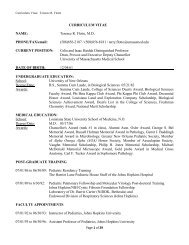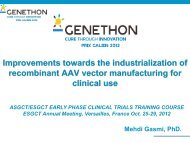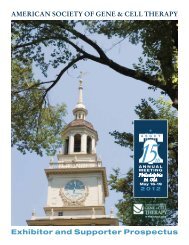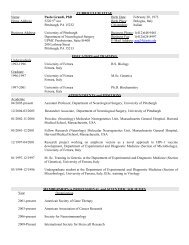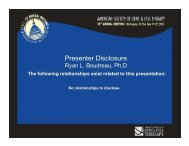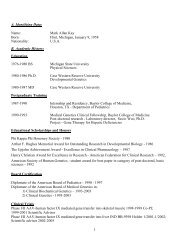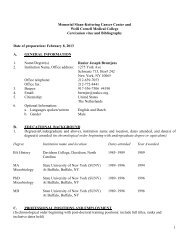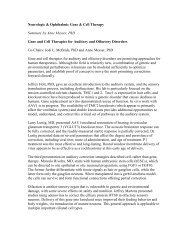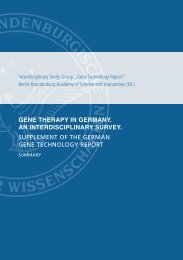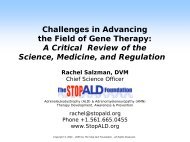FINAL PROGRAM - American Society of Gene & Cell Therapy
FINAL PROGRAM - American Society of Gene & Cell Therapy
FINAL PROGRAM - American Society of Gene & Cell Therapy
- No tags were found...
Create successful ePaper yourself
Turn your PDF publications into a flip-book with our unique Google optimized e-Paper software.
13 th AnnUAL MEETing | Washington, DC USA May 19-22, 2010 51Program ScheduleKevin V. Morris, PhDUtilizing the Endogenous Long Non-Coding RNA Pathway in Human <strong>Cell</strong>s to Transcriptionally Modulate <strong>Gene</strong> ExpressionObservations over the last few years have demonstrated that non-coding RNAs can transcriptionally modulate gene expression in human cells. Recent data hasinferred long non-coding RNAs as endogenous effector molecules regulating gene transcription in human cells. Importantly, this non-coding RNA based mechanism canbe taken advantage <strong>of</strong> to either transcriptionally silence gene expression in a specific long-term manner or activate gene transcription by the targeted degradation <strong>of</strong>gene specific regulatory long antisense non-coding RNAs.Thursday, May 20 thBakhos A. Tannous, PhDEx-Vivo Monitoring <strong>of</strong> In Vivo <strong>Gene</strong> and <strong>Cell</strong> <strong>Therapy</strong>Secreted reporters are useful tools for the detection and non-invasive monitoring <strong>of</strong> different biological processes in experimental models. We have characterized thenaturally secreted Gaussia luciferase (Gluc) as a highly sensitive reporter for quantitative assessment <strong>of</strong> cells in vivo by measuring its activity in few microliters <strong>of</strong>blood. The Gluc blood level is linear with respect to cell number and therefore is a sensitive tool for monitoring tumor growth and response to therapy, gene transfer,viral infection and replication, transcription factor activation, as well as circulating cells survival and proliferation. We also applied the Gluc assay to monitor the effect<strong>of</strong> novel gene therapy based on the constitutively active mutant human brain sodium channel as well as tumor-specific nuclear factor kappa B inducible system drivingthe expression <strong>of</strong> a suicidal gene. The Gluc blood assay complements in vivo bioluminescence imaging which has the ability to localize the signal and provides amultifaceted assessment <strong>of</strong> biological processes in experimental disease and therapy models.Charles P. Venditti, MD, PhD<strong>Gene</strong> <strong>Therapy</strong> for Methylmalonic Acidemia (MMA)The hereditary methylmalonic acidemias are inborn errors <strong>of</strong> metabolism and are excellent candidates for gene and cell therapy. We have generated new insights frommouse models and patient investigations to instruct successful pre-clinical experiments. To facilitate the implementation <strong>of</strong> clinical gene therapy for MMA, we havedeveloped and validated a sensitive isotope ratio mass spectrometry technique to non-invasively monitor whole-body metabolic effects after gene delivery.



